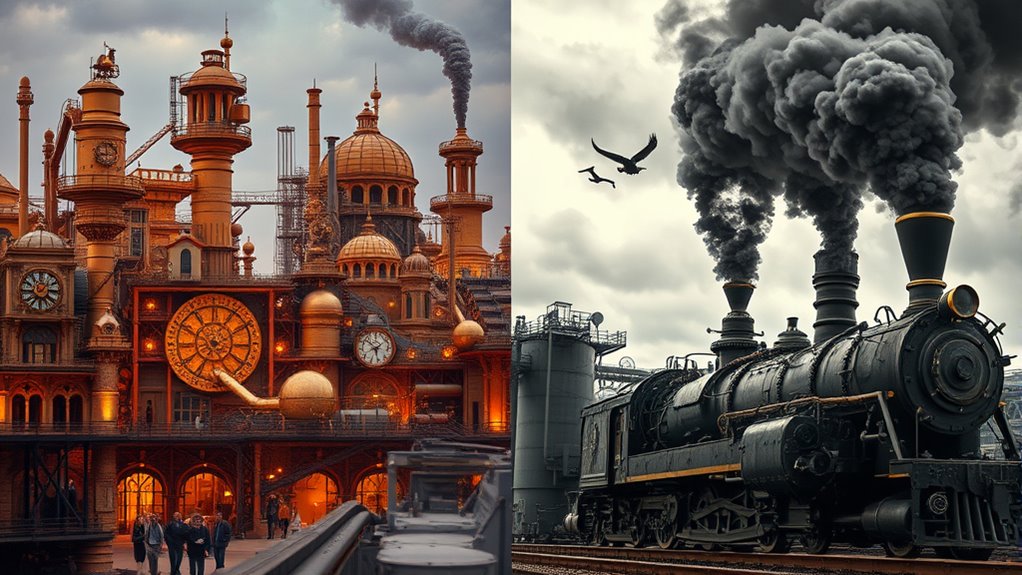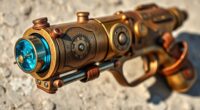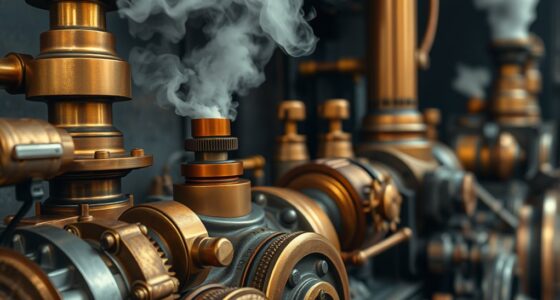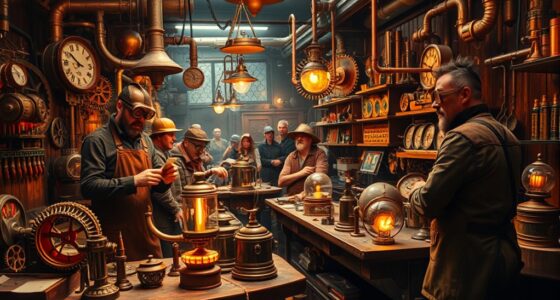Steampunk and dieselpunk showcase different technological worlds rooted in their respective eras. Steampunk emphasizes Victorian aesthetics with intricate gears, brass machinery, and steam power, highlighting craftsmanship and mechanical ingenuity. Dieselpunk draws from early 20th-century styles, focusing on diesel engines, streamlined designs, and modernist influences, often emphasizing power and industrial strength. Their contrasting technologies shape distinct societies and themes, and exploring further reveals how these innovations define their unique worlds in detail.
Key Takeaways
- Steampunk uses Victorian-inspired, handcrafted steam-powered machinery, while Dieselpunk features streamlined, industrial diesel engines from the early 20th century.
- Steampunk devices emphasize craftsmanship, gears, and ornate design; Dieselpunk focuses on modernist, sleek, and powerful machinery.
- Steam technology centers on boilers and steam engines; Diesel technology relies on internal combustion and diesel engines.
- Steampunk aesthetics draw from Victorian-era engineering and romanticism; Dieselpunk reflects modernist, Art Deco, and wartime industrial styles.
- The themes differ: Steampunk celebrates creativity and craftsmanship; Dieselpunk highlights power, speed, and military strength.
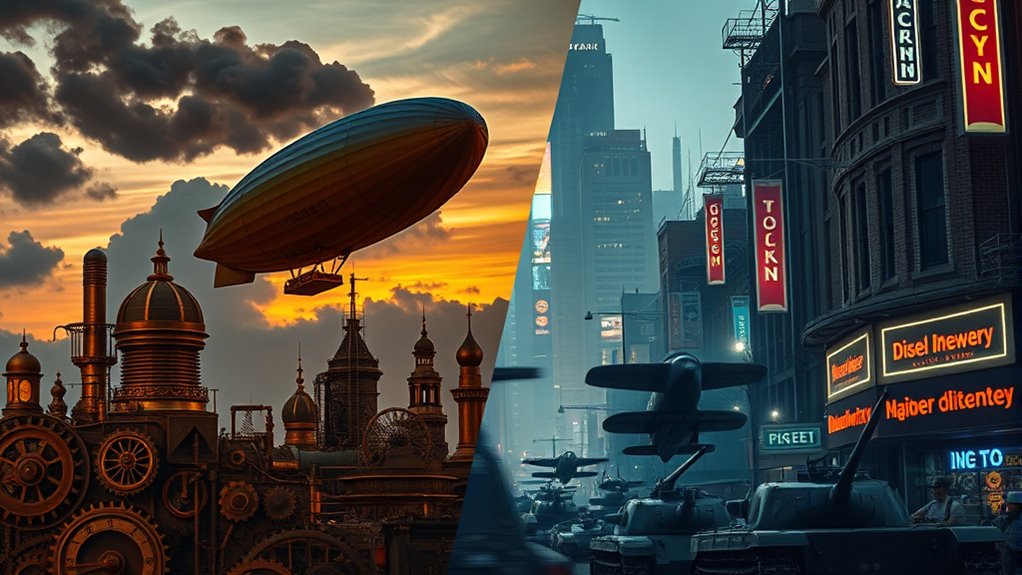
Steampunk and dieselpunk are two enthralling subgenres of speculative fiction that blend historical aesthetics with futuristic imagination. When you explore steampunk, you’re immersed in a world shaped by Victorian aesthetics, where intricate gears, brass machinery, and elaborate fashion evoke a bygone era’s elegance. This subgenre draws heavily on the 19th-century Industrial Revolution, highlighting industrial innovation that seems both nostalgic and fantastical. You’ll notice that steampunk technology often appears handmade, with an emphasis on craftsmanship, steam power, and mechanical ingenuity. It’s like stepping into a Victorian-era fantasy, where clockwork devices and ornate airships symbolize progress and style.
In contrast, dieselpunk takes a different approach. It’s rooted in the early-to-mid 20th century, especially during the interwar period and World War II. The aesthetic leans toward the gritty, rugged, and streamlined, with a focus on diesel engines, mass production, and modernist design. You’ll see influences from Art Deco, aviation advances, and military technology, emphasizing industrial innovation through the lens of a rapidly evolving modern world. Diesel technology, such as powerful engines and heavy machinery, drives the narrative, giving it a more industrial and aggressive feel compared to the ornate elegance of steampunk. The aesthetic often portrays a world of mechanized warfare, sleek vehicles, and robust machinery, emphasizing efficiency and power over ornamentation.
The technological differences stem from their respective historical inspirations. Steampunk’s reliance on steam power means you’ll encounter devices like steam-powered robots, clockwork automatons, and airships that seem to push the limits of Victorian engineering. These machines often combine Victorian aesthetics with imaginative innovations, creating a sense of wonder rooted in craftsmanship and mechanical complexity. Meanwhile, dieselpunk’s machinery is grounded in the technological advancements of the 20th century—think diesel engines, tanks, fighter planes, and mass-produced automobiles. These reflect a shift towards industrial efficiency and modern engineering, often with a darker, more militarized edge.
Both subgenres celebrate industrial innovation, but they do so through different lenses. Steampunk emphasizes creativity, craftsmanship, and the romanticism of Victorian technology, while dieselpunk highlights the power, speed, and brute force of modern machinery. Your experience of these worlds depends on whether you prefer the ornate, whimsical charm of steam-powered Victorian inventions or the sleek, aggressive machinery of the diesel era. Each offers a unique vision of how technology shapes society, blending history with imagination in enthralling ways.
Frequently Asked Questions
How Do Aesthetics Influence Technology Choices in Steampunk and Dieselpunk?
Your aesthetics heavily influence technology choices in steampunk and dieselpunk by emphasizing Victorian innovation and aviation aesthetics. In steampunk, you see a preference for intricate, Victorian-inspired machinery, leading to the use of gears and steam-powered devices. Conversely, dieselpunk adopts a gritty, industrial look, favoring robust diesel engines and aviation-inspired designs. These visual styles shape the technology, reflecting each genre’s unique cultural and historical inspirations.
Are There Any Crossover Technologies Between Steampunk and Dieselpunk?
Think of crossover technologies as bridges connecting two worlds. You’ll find hybrid innovations and crossover artifacts blending steampunk’s vintage charm with dieselpunk’s industrial grit. For example, steam-powered vehicles with diesel engines or Victorian-inspired gadgets with modern diesel technology. These innovations create intriguing combinations, proving that even in contrasting domains, creativity thrives. Embrace the fusion, and you’ll see how these two aesthetic realms can share technological DNA.
How Do Cultural Influences Shape Technological Development in Both Genres?
You see that cultural symbolism and societal values greatly influence technological development in both genres. In steampunk, you notice a fascination with Victorian ideals, craftsmanship, and innovation, reflecting nostalgia and a love for history. Conversely, dieselpunk emphasizes industrial progress, wartime resilience, and modernity, showcasing societal values around progress and power. These cultural influences shape the aesthetics, purpose, and design of their imagined technologies, making each genre uniquely reflective of its historical inspiration.
What Role Does Industrialization Play in Each Genre’s Technological Evolution?
Industrialization drives both genres’ technological evolution by fueling mechanical innovation and shaping societal impact. In steampunk, you see a focus on Victorian-era steam-powered machinery, emphasizing craftsmanship and aesthetic appeal. Dieselpunk, however, reflects the industrial boom of the early 20th century, highlighting diesel engines and mass production. You’ll notice how each genre’s industrialization influences their unique blend of technology and cultural identity, shaping their distinct worlds.
How Do Environmental Considerations Impact Technological Designs in These Genres?
You notice that environmental considerations influence designs in both genres by emphasizing sustainable materials and pollution control. In steampunk, you see a focus on repurposing Victorian-era technology with eco-friendly innovations, while dieselpunk often incorporates pollution-control tech in industrial machinery. You realize that these genres reflect a desire to balance technological progress with environmental impact, encouraging creative solutions that prioritize sustainability and reduce pollution in their imaginative worlds.
Conclusion
In the end, the lines between steampunk and dieselpunk blur more often than you’d think, as both draw inspiration from the past’s technological dreams. It’s no coincidence that their worlds occasionally intertwine, reflecting humanity’s fascination with innovation. Whether you prefer the Victorian elegance or the gritty industrial grit, understanding their subtle differences deepens your appreciation. After all, history has a way of repeating itself, weaving these contrasting visions into a surprisingly harmonious narrative.
